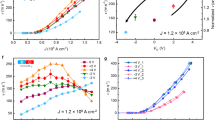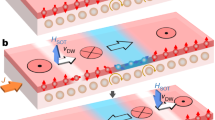Abstract
The walls of magnetic domains can become trapped in a ferromagnetic metallic point contact when the thickness of the film and the width of the contact are less than their critical values1. The discovery that domain walls can be moved from such constrictions by a sufficiently large current has attracted considerable attention from researchers working on both fundamental research and potential applications2,3,4,5,6,7,8,9,10,11,12. Here we show that Invar nanocontacts fabricated on silica substrates exhibit a sharp drop in resistance with increasing bias voltage at room temperature in the absence of an applied magnetic field. Moreover, when two nanocontacts are combined in an all-metallic comparison circuit, it is possible to perform logical NOT operations. The use of electrical currents rather than applied magnetic fields to control the domain walls also reduces energy consumption and the risk of crosstalk in devices13,14.
This is a preview of subscription content, access via your institution
Access options
Subscribe to this journal
Receive 12 print issues and online access
$259.00 per year
only $21.58 per issue
Buy this article
- Purchase on Springer Link
- Instant access to full article PDF
Prices may be subject to local taxes which are calculated during checkout




Similar content being viewed by others
References
Lepadatu, S., Xu, Y. B. & Ahmad, E. Current induced magnetic switching in Ni80Fe20, Ni, Fe, and Co wires. J. Appl. Phys. 97, 10C711 (2005).
Yamaguchi, A. et al. Real-space observation of current-driven domain wall motion in submicron magnetic wires. Phys. Rev. Lett. 92, 077205 (2004).
Lepadatu, S. & Xu, Y. B. Direct observation of domain wall scattering in patterned Ni80Fe20 and Ni nanowires by current–voltage measurements. Phys. Rev. Lett. 92, 127201 (2004).
Bagrets, A., Papanikolaou, N. & Mertig, I. Magnetoresistance of atomic-sized contacts: An ab initio study. Phys. Rev. B 70, 064410 (2004).
Yamanouchi, M., Chiba, D., Matsukura, F. & Ohno, H. Current-induced domain-wall switching in a ferromagnetic semiconductor structure. Nature 428, 539–542 (2004).
Labaye, Y., Berger, L. & Coey, J. M. D. Domain walls in ferromagnetic nanoconstriction. J. Appl. Phys. 91, 5341–5346 (2002).
Ono, T. et al. Propagation of a magnetic domain wall in a submicrometer magnetic wire. Science 284, 468–470 (1999).
Thomas, L. et al. Oscillatory dependence of current-driven magnetic domain wall motion on current pulse length. Nature 443, 197–200 (2006).
Laufenberg, M. et al. Temperature dependence of the spin torque effect in current-induced domain wall motion. Phys. Rev. Lett. 97, 046602 (2006).
Ohe, J. & Kramer, B. Dynamics of a domain wall and spin-wave excitations driven by a mesoscopic current. Phys. Rev. Lett. 96, 027204 (2006).
Beach, G. S. D., Knutson, C., Nistor, C., Tsoi, M. & Erskine, J. L. Nonlinear domain-wall velocity enhancement by spin-polarized electric current. Phys. Rev. Lett. 97, 057203 (2006).
Versluijs, J. J., Bari, M. A. & Coey, J. M. D. Magnetoresistance of half-metallic oxide nanocontacts. Phys. Rev. Lett. 87, 026601 (2001).
Allwood, D. A. et al. Submicrometer ferromagnetic NOT gate and shift register. Science 296, 2003–2006 (2003).
Allwood, D. A. et al. Magnetic domain-wall logic. Science 309, 1688–1692 (2005).
Saitoh, E., Miyajima, H., Yamaoka, T. & Tatara, G. Current-induced resonance and mass determination of a single magnetic domain wall. Nature 432, 203–206 (2004).
Tatara, G. & Kohno, H. Theory of current-driven domain wall motion: spin transfer versus momentum transfer. Phys. Rev. Lett. 92, 086601 (2004).
Acknowledgements
We wish to thank Dongmin Chen, Enge Wang and Zheng Cui for fruitful discussions. This work was supported by the National Natural Science Foundation of China (grant no.90406024-1), the Ministry of Science and Technology of China (grant nos 2006CB933000 and 2006AA03Z402) and the Knowledge Innovation Program of the Chinese Academy of Sciences (CAS), China.
Author information
Authors and Affiliations
Contributions
C.G. and K.X. conceived and designed the experiments. P.X., H.Y. and J.L. performed the experiments. C.G., K.X., P.X. and L.T. analysed the data. C.G., P.X. and K.X. co-wrote the paper. All authors discussed the results and commented on the manuscript.
Corresponding authors
Supplementary information
Supplementary Information
Supplementary information and supplementary figures S1–S3 (PDF 715 kb)
Rights and permissions
About this article
Cite this article
Xu, P., Xia, K., Gu, C. et al. An all-metallic logic gate based on current-driven domain wall motion. Nature Nanotech 3, 97–100 (2008). https://doi.org/10.1038/nnano.2008.1
Received:
Accepted:
Published:
Issue Date:
DOI: https://doi.org/10.1038/nnano.2008.1
This article is cited by
-
Spintronic devices: a promising alternative to CMOS devices
Journal of Computational Electronics (2021)
-
An electrically reconfigurable logic gate intrinsically enabled by spin-orbit materials
Scientific Reports (2017)
-
Synthetic ferrimagnet nanowires with very low critical current density for coupled domain wall motion
Scientific Reports (2017)
-
Piezo Voltage Controlled Planar Hall Effect Devices
Scientific Reports (2016)
-
Reconfigurable logic via gate controlled domain wall trajectory in magnetic network structure
Scientific Reports (2016)



